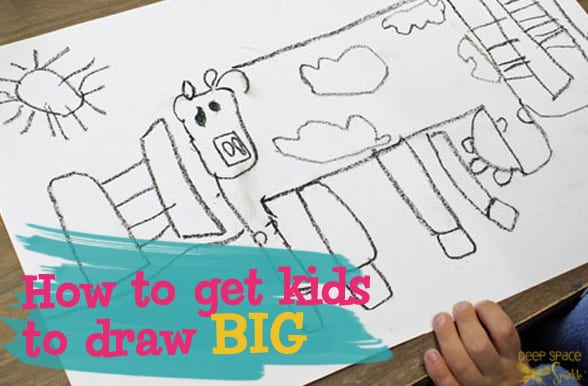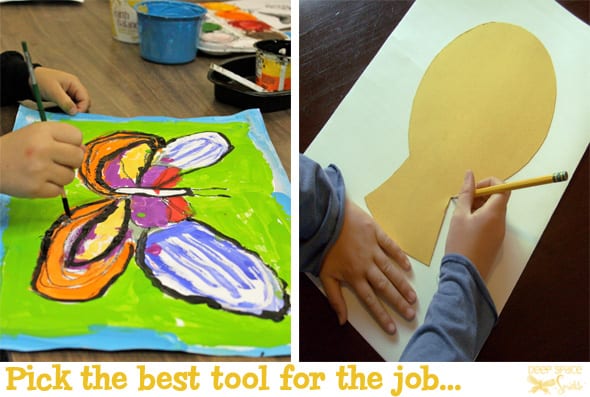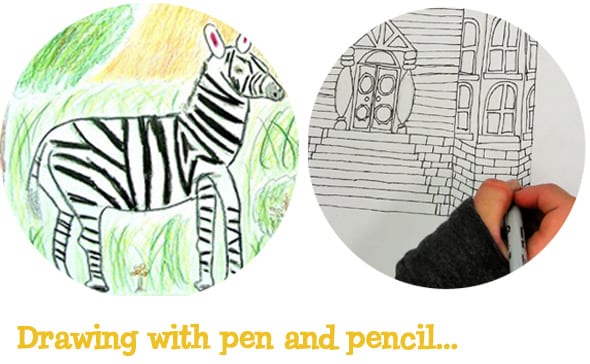
How do you encourage children to produce images large enough to paint or color? It’s a great question, isn’t it? One of my DSS Facebook readers asked this very question so here is my response….
How you choose techniques and tools will greatly determine how “big” a child will draw. Pencils are not a regular part of my art room for the mere fact that they encourage details and details are usually small in nature. Of course, there are other reasons why I don’t use pencils but one of them is because you can erase a pencil line. That’s not necessarily a bad thing, but that’s a whole other post!
Use oil pastels…
In most of my art lessons, I have my students use oil pastels or paint brushes to draw with. This is especially true with my Kinders through 3rd grade students. I love how forgiving an oil pastel is. There is no pointy end to draw the tiny details with. Oil pastels literally beg to be stretch across the entire page. If a child makes a “mistake”, we simply paint over it and if we aren’t using paint, we may just ignore the pesky problem altogether.

Try templates…
No matter how you feel about them, templates (or tracers) are a great way for a child to draw bigger. I love to use an oval template when doing portraits lessons with my Kinder classes. Once the main shape is made, children create facial features, hair and clothes for their portraits.
What about crayons?
You would think that crayons have a similar quality and outcome as oil pastels, but they are really different. I rarely use crayons for drawing because the nature of the crayon means that you need to press just a little bit harder to achieve a smooth line. Drawings tend to be more rigid anytime pressure is applied. Go ahead and try it. Draw an image (say a butterfly) using crayons and then again using oil pastels. What did you discover? How does the medium feel in your hands? Think about this before you teach your students.
Filling up the paper…
Technique also plays a big part in determining how big a child will draw. I like to do directed line drawings with my younger students. Simple tricks such as finger placement, making a dot where the eye should go and talking about the edges of the paper will help develop the space children view as their canvas. I continue with these instructions all throughout the grades and soon, the children realize that small drawings are hard to paint and large ones are much, much easier!
When to use pencils…
Sometimes I will use pencils to help develop the drawing techniques for older students (grades 5 and 6). These drawings are often done on smaller sized paper so that the student can focus on the details. Pencil is used to lay down the foundation lines when a project calls for detailed work such as castles or victorian homes project.

New to teaching art in the classroom? Download my free classroom art teachers toolkit by clicking the yellow box below!












Thank you so Much!
I think you were reading my mind…I just asked myself this the other day. My grandkids especially one LOVES to draw and paint and cut and paste and you name it. But like you said they draw so tiny. I will give your suggestions a try. Love this blog and you inspire creativity. Thanks!
One assignment I have is for kids to draw monsters. To make them large, I give them circles to trace for the eyes, which they do first, then they build around that to make the rest. They all turn out awesome and are all different.
Yes, great idea! Giving a jumping off point not only encourages creativity but really help with the mechanics of drawing large.
I agree totally, I’ve been phasing out using pencils for pre-drawing for a while now, for the exact same reasons! Through trial and error I’m using oil pastels instead. I wish I’d read this post 6 months ago!!
I always make two examples, one good and one bad, then kids decide why one is good and the other bad. I always draw the bad one much smaller than than the good one- kids pick up on it right away and I have very few problems with teeny-tiny drawings…..
That’s a good idea. Sometimes I don’t have time to make two samples but when I do I will do two.
I earn so much from you. Thank you.
love your blog! thanks so much. I have just starting using pencils again after the children have begged for them but I agree they spend the whole time erasing and drawing small. but do you not find oil pastels to be so messy!!?? especially with the younger ones??
I really don’t find oil pastels messy. There are different “oil” levels in oil pastels as some are very soft, which would obviously be very messy for little ones. Now, chalk pastels are extremely messy, but that’s a different story!
I’m not as big a fan of oil pastels as you. For pre-drawing for painting, when I want something big, I would have kids use crayon, or if I don’t want the line to be visible,or if the artwork is on colored paper, I love using a piece of chalk for drawing. It can be easily rubbed out and also can be painted over.
I use their hand as the measuring two. “Make the body three hands high and two hands across.” Or, “try to draw your head three hands big.”
I had to smile when I saw this post. How many times have I found drawings that are almost microscopic with huge white space all around them. I love your suggestions. I’m visiting from BYW class. So glad I found your great resources. Great inspiration to foster our little one’s creativity.
Plan out where you wish to place posters, lettering, etc. on glass by drawing on the BACK of the glass with a whiteboard marker. Adhere your items then wipe off the marker from the back. This is a great tip for placing lettering in straight lines.
I was so excited to find this blog post! I’m a homeschool mom and we’ve just started, in the past few weeks, exploring art a little more deeply. I grew up hating art. I couldn’t tell you why, it was just the class I most dreaded during school. I probably felt I wasn’t good at it and therefore didn’t want to bother. I don’t remember.
But I love viewing and learning about art and I didn’t want my kids to be as averse to it as I was. So we’ve just been taking the time several times a week to learn together using various art books we’ve found. I’m now going to incorporate this blog into my curriculum.
Anyhow, I’ve noticed my daughter’s drawings being so very tiny and all of this massive space around it that she usually fills with patterns or colors. But I haven’t known how to respond to it. Probably wouldn’t have even thought to pose the question, “Why is my kid’s drawing so tiny?” I’ve mentioned to her that if she wants to paint the details in the drawing, she might want to make it a little bigger. But those particular words haven’t impacted her drawing. I also know in my head about the concept of scale, but can’t manage to communicate it. This post helps immensely. Some good stuff in the comments too.
Thank you so much for this very helpful blog, from a very inept art teacher/homeschool mom.
Wish I had read this post before I led some young children through a recent project where drawings need to be big. Getting rid of my pencils!
Some great tips here. I always struggle with teeny-tiny drawings with my youngest students. Huge fan of your blog, Patty- so many wonderful ideas that you generously share with everyone!
Ah! So useful. I remember being frustrated as a child that my teachers wanted me to draw bigger… I have little hands, why should I draw so big?! But now as an art tutor I am frustrated that my students want to draw so tiny, and take forever so it is hard to finish a lesson in the allotted time. This article helps me not only with tactic, but also how to explain to determined minaturists why sometimes bigger is better.
pastels are way better than crayons-as an artist and teacher I do not let my students use crayons-. if you can remember what pastels felt like as a kid, you would definitely love pastels.kids somehow dont mind the mess with pastels but somehow with pencils they know it requires detail and can be erased. pastels also blend easier
Just by this site I have disregard using pencils to draw and it has been working out like a charm. However the black pastels from Blick. I did find them very soft and messy. I did buy colorations pastes and they had seemed harder and less messy
Nice how to draw drawing lesson. Children learn easily.
Rahul
Great post!! Any suggestions for children who are perfectionist when drawing with crayon/oil pastel. I have kids that lose it if it’s not perfect and refuse to go on. They want another paper and I don’t have the budget for that. This especially happens with guided drawing.
Guided Drawing instruction is an art in itself. The trick is to establish a set of guidelines for both the student and teacher but know when to break them. If more than 3 kids are having “perfectionist” issues, it might help to examine how you are teaching the lesson. Ask yourself if the drawing is too difficult for the group (lots of outbreaks = big clue to the drawing being too hard), what your level of tolerance is (are you allowing children to veer off your instructions and do it their way?) and how you teach the lesson.
If the same child has the same reaction every time you teach a drawing lesson, it’s very helpful to give this child parameters that match the class. ie. just one paper (use the other side). If it’s a different child, and it’s unusual for him to cause a fuss, just give him a new paper.
There are so many variables to this question and one that I hope to address with my new podcast. Sign up to my newsletter to stay up-to-date with the topics!
Great question.
I always tell me children to draw something “bigger than their fists”
So every time they draw they would put their fists to their drawing and compare.. if it is smaller than their fists, they’ll automatically re-do it.
It’s a self-check method that has worked for me so that I don’t have to go around reminding everyone to draw big.
I saw this post was created about 4 years ago. I just started to be an art instructor and I am just starting to teach children other than my own kids, and boy I just discovered why the initial instructions contained a suggestion for the children encouraging them to draw big , I even give it in the initial instructions of every class but still they are drawing tiny ! I was getting a bit frustrated but now I realize it could be the pencils. I’m going to give them oil pastels next time instead and put pencils away. I am also going to figure out how to use some sort of a template or initial line guidance to start the drawing with.
Does someone have an idea why children tend to draw tiny and leave most of the white page empty???? All of them do that. I wonder why that is.
Thanks Patty for your suggestions and wonderfoul site full or resources for us new art teachers.
Lesly Chamate
I’m about to teach your Homer Clipper ship lesson to my 4th graders to complement their explorers unit in S.S. 🙂
I found a simplified clipper ship coloring page for us to use and I will do teacher directed drawing for this one.
The paper is large- we want them to be big! The 4th graders still have trouble filling the space. Some of their ships will be tiny- so I’ll talk to them about the edges of the paper, & before we draw, we will place a dot where the tallest sail should go and the left/right side of the ship.
Do you recommend a better way for this?? I’m a new art teacher! I noticed quickly that children love to draw small. “Shrunken head” self portraits are the tendency, so I really have to review this with them beforehand 🙂
Even the older ones… Thank you!
The trick here is the demonstration. You don’t necessarily need to do a directed drawing with kids at this age. What I like to do is have the kids watch me draw. I’ll show them why it’s important to start with the stern, etc. Make sure to use descriptive language: the mast is as tall as the stern is long, the bow almost reaches the left side of the paper, etc.
I also like to draw a large scale paper on the white board and show how big to make the boat.
Hope this helps!
When demonstrating a drawing for children I always begin by drawing a frame on the whiteboard or chart paper. This frame gives them a visual reference when creating their own drawings.
Great Tip!
Thank you for your great ideas-I am a teacher starting out this year & I need all the teaching tips I can get!
I have told students their drawings need to touch at least 3 sides of the paper. Sometimes all the sides of the paper. Had a successful project having second graders use the paragraph describing the dragon My Father’s Dragon to draw and paint a dragon. I added a bit of gold paint to the wings.
Super helpful! Thank you 🙂
Great tips. I love the idea of having the students draw with a crayon and then try the same drawing with an oil pastel to see/feel the difference.
Thanks, Patty! Great ideas. I would also recommend some other techniques as “warm ups” to drawing big on the paper. During Guided Drawings, I teach the children how to draw with their magic drawing finger and they do invisible drawing onto their paper as they mentally and physically imagine the drawing lines and shapes. They are quiet during this time. I demo first the technique. Then, I have them do an invisible drawing practice onto their paper as they concentrate on “picturing” or invisioning in their minds their lines and shapes and placements. This helps to relax the children and to create a sort of “muscle memory” for the placement and shapes of their drawing.
Hi, I can’t open the classroom teacher’s toolkit .
pls help
Hi Annie! This is Bethany from Team Sparkle. Thanks so much for letting us know that there is an issue with the link. We working on getting that taken care of, so please try again shortly. Thanks!
I am a self taught ceramics artist whose granddaughter’s mother wants me to teach her daughter to be an artist. Your videos etc are a wonderful resource helping me successfully do this so thank you for your insight and practical hints!
I’m preparing for the new year and getting my binders set up.